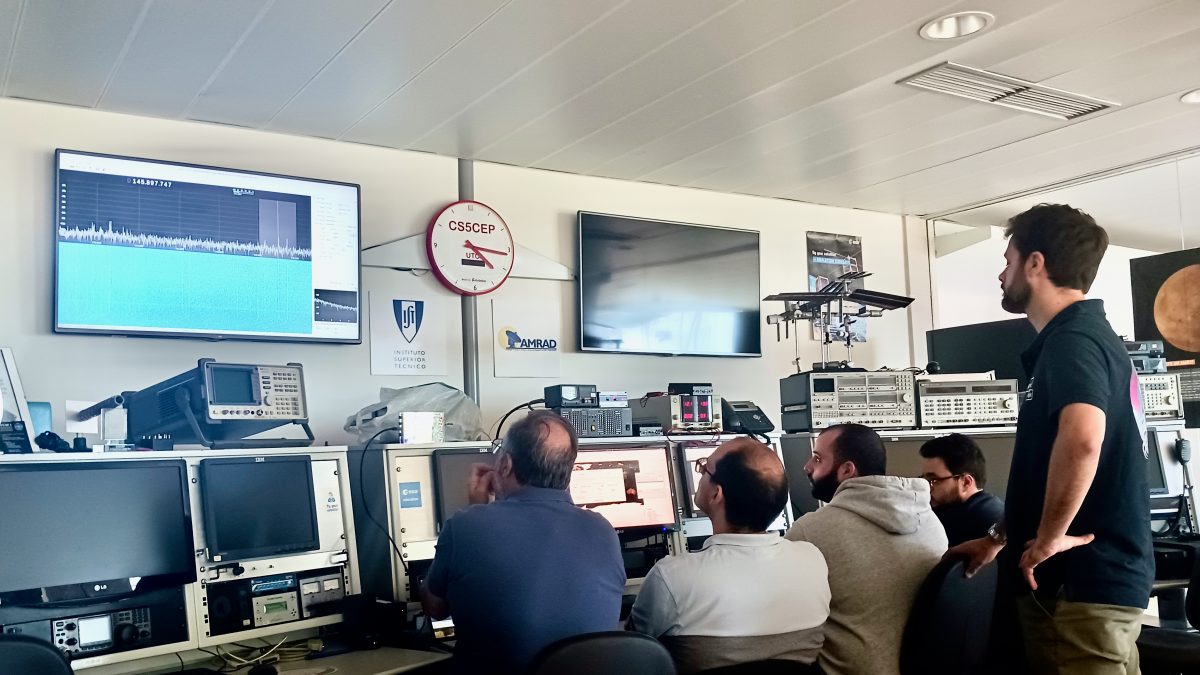
Researchers from the IST Nanosat Lab receiving data of the ISTSat-1, at Técnico Oeiras
Yes, ISTSat-1 solar panels are charging in space
It is confirmed! The ISTSat-1 solar panels are working properly and charging the batteries. “It made my day,” says João Paulo Monteiro, a researcher at IST Nanosat Lab, minutes after the team received another piece of data from the first university CubeSat entirely developed and built in Portugal, launched on July 9.
Since the CubeSat departed from French Guiana aboard the Ariane 6’s maiden flight, the project team has been working day and night, looking after ISTSat-1. “It’s almost like taking care of a newborn,” admits João Paulo, as the satellite may ‘cry’ at one in the morning, at noon, or at seven PM.
Every 90 minutes, the satellite passes over the antennas placed at Técnico Oeiras, each time at a different angle. And amidst the noise captured by the equipment, the researchers are able to extract determinant information about the satellite. Only when the inclination of the satellite’s orbit is around 60 degrees is it a good chance to gather data. Usually, there are four good chances per 24 hours, and the amount of good news has been increasing, signal after signal, like baby steps.
So far, the team knows it is cold out there – at 580 km from Earth – around 6 °C, as expected. The system is performing the predicted reboots, and the small cube is rotating at the desired speed. And fresh out of the bottle, we now know the energy system is fully operational. “It was a critical aspect,” admits João Paulo.
Developed at Técnico, under the coordination of Rui Rocha, professor at IST and researcher at Instituto de Telecomunicações (IT), the ISTSat-1 project involved a team of around 50 people since its inception.
As the pieces were being put together, a consortium was created to maximize the benefits of this pioneering event and others to come, and thus the NanosatLab consortium came to light, gathering IST, IT, INOV, INESC-MN, IDMEC, IST-ID/ISR-Lisboa, with INESC-ID as the leader.
This week, the NanosatLab consortium had its first meeting, with the participation of Fernando Mira da Silva (IST), Carlos António Cardoso Fernandes (IT), António Gomes Leal (INOV), Susana Cardoso de Freitas (INESC-MN), Afzal Suleman (IDMEC), Rodrigo Ventura (IST-ID/ISR), Inês Lynce (INESC-ID) and the consortium directors Rui Rocha and Gonçalo Tavares.
Regarding ISTSat-1, it is expected that during its five-year mission lifespan, the nanosatellite will capture and transmit messages from an air traffic monitoring system called ADS-B. This system involves aircraft broadcasting their positions, enabling other aircraft and ground terminals to receive this information.
Text by Sara Sá, Science Writer | Communications and Outreach Office, INESC-ID / © 2024 INESC-ID
Images | © 2024 INESC-ID
